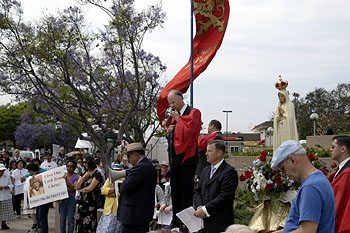 It seems like ages but it was barely a year ago when media hype was heralding The Da Vinci Code as the unstoppable and unforgettable film of 2006. Like the book that dominated The New York Times Best-Seller list for over two years, Sony’s Columbia Pictures had high hopes for the movie. Marketers were already planning to spin off brand products to ride the wave.
It seems like ages but it was barely a year ago when media hype was heralding The Da Vinci Code as the unstoppable and unforgettable film of 2006. Like the book that dominated The New York Times Best-Seller list for over two years, Sony’s Columbia Pictures had high hopes for the movie. Marketers were already planning to spin off brand products to ride the wave.
With champagne bottles ready, everything seemed set for the celebrations … except for one tiny dot on the distant horizon.
Uneasy Controversy
That tiny dot was an unsettling controversy around the film which gradually spread all over the country. The book’s blasphemous affirmations denying the Divinity of Christ and claiming He was married to Saint Mary Magdalene and had children offended countless faithful. Numerous books and studies soon appeared that debunked these absurd and horrific theses and others that author Dan Brown nevertheless affirmed were true.
Sony Pictures tried to stem the growing uprising by hiring an expensive Hollywood public relations firm specializing in “reputation management” and another for dealing with troublesome Christians. Promoters spread ad nauseam the mantra that the film was “only fiction” and not to be taken seriously. Others sought to discourage protests by claiming it would only add to the publicity and Sony’s bottom line.
Mobilizing for Action
Such efforts only seemed to add fuel to the fire. As the release date neared, many Catholics wanted to do more than just complain about the film’s blasphemous content. Protests began to be organized. Voices started to be heard.
Among these was a massive effort by the American Society for the Defense of Tradition, Family and Property (TFP) and its America Needs Fatima campaign. What began as a small effort to find a few local organizers soon mushroomed into a huge nationwide grassroots network of activists in all fifty states.
This TFP network enjoyed an impressive outpouring of support from Americans from all walks of life. Everyone wanted to get involved. Housewives, students and professionals suddenly found themselves on the front line in today’s Culture War. People who never thought about defending publicly Our Lord and the Blessed Mother suddenly were leading the charge and making a stand.
Eleven American Catholic bishops eventually joined in encouraging such protests in front of theaters. Numerous priests denounced the film and announced the protests from the pulpit.
By May 19, 2006, when The Da Vinci Code was released nationwide, the film was embroiled in a quagmire of controversy. The tiny dot on the horizon suddenly turned into a huge storm. Media was everywhere reporting on the protests. By the time it was all over, outraged Catholics had logged in an impressive 2,092 protests across the nation.
Protesters also organized over 1,000 Holy Hours of reparation on June 18. On June 24, activists gathered at the two Sony headquarter locations in New York and Los Angeles for a final opportunity to voice their outrage at the corporate entertainment giant’s endorsement of blasphemy.
Negative Publicity
What happened to The Da Vinci Code? With all the publicity, the film had all the momentum and hype to make it a blockbuster even with its negative reviews at the Cannes Film Festival.
In fact, on May 19, the movie opened with plenty of fanfare and impressive opening weekend ticket sales. However, after the first weekend of protests, the climate radically changed. A curtain of silence fell over both the film and the protests. No one was talking about The Da Vinci Code anymore.
And did the protests work? In the United States where there were protests, the film ticket sales fell flat. However, two thirds of the receipts came from international markets where no protests were held. Negative publicity had its effect. The fact remains that the spin-off market of Da Vinci Code-branded merchandise simply did not get off the ground. The book suddenly fell off the best-seller lists. The film was not even in the running for Hollywood film awards.
Perhaps one of the greatest results of the protests was the sentiments of so many Catholics nationwide who experience the joy of standing up for Our Lord and Holy Mother Church in the secular public square.

And Sony?
Since the release of The Da Vinci Code, things have also not gone well with Sony. And while one cannot link the bad fortunes of the corporate giant to the film, one cannot but take note that Sony has unexpectedly lost many times over any profit it might have gained from the film.
Since the film’s debut, the company has been plagued with a long litany of problems, infighting, delays and mistakes. In fact, Sony has just posted its worst quarterly loss in four years to the tune of $583 million.
In August of last year, Sony’s lithium ion batteries used in laptop computers mysteriously started catching fire. The company scrambled to control damage to its reputation and spent nearly $434 million on recalling and replacing the Sony batteries in 10 million laptops from Dell, Apple, Lenovo and other companies.
Sony has also been plagued by the marketing and developing of PlayStation 3, its new game console which it had hoped would become its new cash cow. Factory delays, high production costs and a bad marketing strategy have cut deeply into Sony’s market share which stood at 70 percent with the PlayStation 2. The new product now ranks third behind Nintendo’s Wii and Microsoft’s Xbox 360.
To remain competitive, Sony was forced to sell each new PlayStation 3 at a significant loss. As a result, Sony said the games unit lost $2 billion this year. To stay in the market, the firm may have to introduce further price cuts for the game console that will hurt profit margins yet more.
Even Sony’s recent record blockbuster “Spider-Man 3” is not helping significantly to adjust its bottom line. Media reports say production overruns, lavish spending and lagging schedules have made it the most expensive film in the history of Hollywood with cost estimates ranging from $270 million to $500 million1. Thus, higher box office receipts will not necessarily translate into higher profits.
Conclusions To Be Taken
Looking back one year later, there is no doubt that things did not turn out as the film’s promoters expected. The unforgettable film of 2006 has been forgotten. The unstoppable Da Vinci Code juggernaut has lost its steam.
One cannot say that Sony’s attachment to blasphemy was the cause of its unexpected financial woes, mysterious exploding batteries and exasperating production delays. However one can say Sony’s post-film fortunes have certainly not gone according to plan. In addition, 2092 high-profile protests did send Sony a strong message that American Catholics do not take blasphemy lying down
On the part of Catholics, one can conclude that protests work. Standing up for the Faith is something that makes one proud to be a Catholic and brings the blessings of God. It is an encouragement and proof in these times of moral relativism that one can make a difference. The protests also show that, if it can be done once, it can be done again.

